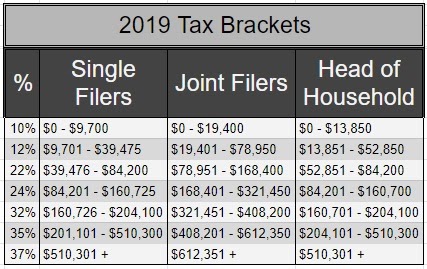If you work as an independent contractor or are self-employed it is important to stay up to date on the latest tax changes. As we start gearing up for tax season, you may be wondering what has changed for tax year 2019 (filed in 2020). With the passage of the Tax Cuts and Jobs Act, a lot of tax changes were implemented last year, like an increase in the standard deduction and an increase in the child tax credit. This year we aren’t seeing a major overhaul like last year, but there are still a few updates and changes you need to be aware of.
For the latest updates, check out our post on tax deadlines and updates for the latest tax year here.
Tax Brackets – Increase In Income Limits
In 2019, there are still 7 tax brackets. However, income limits increased slightly.
Slight Increase In Standard Deduction
The standard deduction nearly doubled in 2018. This year, the changes aren’t as significant, but they increased slightly. Standard deductions changed to these levels in 2019:
- Single Filers: The standard deduction increased from $12,000 to $12,200
- Joint Filers: The standard deduction increased from $24,00 to $24,400
- Head of Household: The standard deduction increased from $18,00 to $18,350
As you can see, the standard deduction only increased slightly last year. However, it’s still pretty hefty, so many 1099 contractors are opting for the standard deduction over itemizing. If you’re a self-employed independent contractor, you need to add up your deductions to see which is the best way to minimize your tax expenses.
Increase In Alternative Minimum Tax (AMT) Exemptions
The AMT ensures that high-income earners pay their fair share in taxes. AMT exemptions also increased substantially in 2018, but it’s only up slightly in 2019. The new AMT exemptions for 2019 tax changes are:
- For Singles Filers, the AMT exemption went up from $70,300 to $71,700
- For Joint Filers, it went from $109,400 to $111,700
- And for Head of Households, it increased from $54,700 to $55,850
Medical Expenses Deduction
Taxpayers can deduct qualified medical expenses once they surpass a certain percentage of your adjusted gross income. The Tax Cuts and Jobs Act lowered the limit to 7.5% for tax years 2017 and 2018. However, the percentage increased to 10% in 2020. As a result, you can deduct only your medical expenses once they exceed 10% of your adjusted gross income.
Elimination of Individual Mandate
Starting in 2019, the Tax Cuts and Jobs Act eliminated the individual mandate that penalized taxpayers without health insurance. However, you might have to deal with something similar at the state level.
States with Penalties for No Insurance: Massachusetts, New Jersey, or the District of Columbia charge penalties to taxpayers without health insurance, unless they have an exemption.
No Alimony Deduction
Starting in 2019, alimony payments will no longer be deductible. If a divorce decree is signed after December 31, 2018, it falls under the new regulations. Alimony payments can’t be deducted from the payer’s taxes, and the receiving party doesn’t have to report the payments as taxable income either.
Alternative Vehicle Credits Expiring
Tax credits helped spur demand for alternative vehicles over the past few years, but they’re phasing out. The credit applies to electric vehicles and plug-in hybrids, and it makes purchasing an EV much more attractive. The government reduces tax credits as vehicle sales increase. Once a manufacturer sells over 200,000 vehicles, the credit begins to phase out.
For example, Tesla reached the 200,000 vehicle milestone in July 2018. As a result, the tax credit reduced to $3,750 for vehicles purchased between January 1, 2019, and June 30, 2019. For vehicles purchased between July 1, 2019, and December 31, 2019, it goes to and $1,875. Starting in 2020, Tesla buyers will no longer receive a federal tax credit.
You can’t get a tax credit for buying a Tesla anymore, but credits still apply to other manufacturers. You can view a complete list of eligible vehicles here.
Retirement Contribution Limits
It’s never too early to start saving for retirement, and there are powerful tax benefits that make it even more sensible. For example, 401K contributions can help decrease your taxable income. In fiscal-year 2019, the maximum 401K contribution limit increased to $19,000.
In addition, you may be able to claim an IRA deduction. The IRA contribution limit increased to $6,000 for 2019. Best of all, this is an above-line deduction, so you can claim it without itemizing. You have until April 15 to make contributions for the previous year so, if you are looking for a last-minute tax deduction, consider making an early-year IRA contribution.
Get Help For Your 2019 Taxes
Tax Day will be here before you know it, and getting a head start is always a good idea. This list briefly covers the 2019 tax changes, but a professional tax advisor can walk you through the new tax rules in detail. Working with a pro is the easiest way to maximize your deductions and minimize your year-end tax bill. Schedule a one-on-one strategy session with a Shared Economy Tax pro today. Click here to get started, or signup for our newsletter for free tax tips and more.

